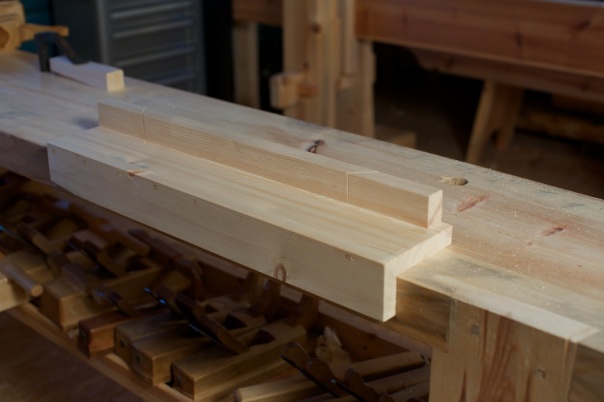This is the first post in English on this blog. After our last post with pictures of the wooden bench hook from the Swedish warship Vasa that sank in the year 1628, we got a lot of English speaking readers and followers. Earlier this week Tomas and I attended at the Vasa museum to study some details of the carpenters/joiners workbench from the ship as we have started to make some copies of the bench to use in our own work. We where allowed to see some of the tools and other interesting objects that where found in the ship. Among the tools where this, now famous, wooden bench hook.

In my own workshop in northern Norway i have made a workbench that is not unlike the Vasa workbench, but it is made of pine and after a model from early 1800 from a farm (Eggagården) in Røros in Norway. The original bench where probably mounted to the wall but I have modified mine to stand free on the floor. I use the bench along with my tools that are copies from old tools from my area and from about 1800-1860.


All the other posts on the blog is in Norwegian (Roald) and Swedish (Tomas). We will continue to write in our own languages, but might write some posts in English as we would like more contact with woodworkers that works with similar things as we do in other parts of the world. Feel free to comment our posts in English and we would try to answer your questions.
This blog is about workbenches for what is called «snikkar» in Norwegian. The word is commonly used to describe a woodworker and could be the same as joiner, cabinetmaker or carpenter in English. As you would understand, there is a lot of different kinds of workbenches that have been used for different purposes. We are focusing on benches for work similar as a joiner. There is another similar blog about workbenches for jointing long boards, a bench called «skottbenk» in Norwegian. (http://skottbenk.wordpress.com) We search both private collections and museums in Norway and Sweden for old workbenches. The modern «Scandinavian» workbench, «høvelbenk«, have become so common that most people do not know other workbenches that that. We will make copies of old benches to try to rediscover some of the old woodworking knowledge.

It is very exciting to see this material, and I am grateful that you are willing to post some English entries. Your photographs are very interesting and useful in any case, and I will keep reading your blog and may manage to pick up some Norwegian or Swedish words in the process. Would you consider writing a brief English abstract of the material you have already posted about the Vasa workbench?
Thank you for your comments. The wooden bench hook, the workbench and the tools from Vasa is very exiting as it is like a time capsule from 1628. There was some interior work still going on when the ship sank so it is possible that the workbench and the tools was for this work.
We have some more research to do before we are ready with the posting about the original Vasa bench. I will consider to write a brief English abstract when we are done with this.
I was fascinated by the earlier photos, very much appreciate the effort on your part to provide some English-language discussion of them.
Wow! This blog lept out of left field. Thanks for taking the time to blog in English too. Love the bench hook concept. It’s great fun taking in all your lovely photos. You have a new subscriber 🙂
Agreeing with the previous commenters, thank you for the English posting. I’ve enjoyed going through your previous posts after being directed here by Follansbee’s blog. Your work is both fun and interesting to see and read about.
Just having the pictures is great, a little English now and then would be nice too. Your blog makes me want to go build things for my own bench and shop!
I am pleased you are going to investigate the Vasa bench. I saw a picture of it some time ago in a general collection of Vasa pictures, and tried to find out more about it. It was my hope that a scandinavian woodworker would see the need in our current woodworker’s enthusiasm for antique benches.
Roald, thank you so much for your English articles! I’ve traveled extensively through Norway, and realize how much of America’s fine craftsmanship came from your country. I saw actual furniture and a stav kirk built by my Norwegian ancestors, and hope to come back and visit your shop some time!